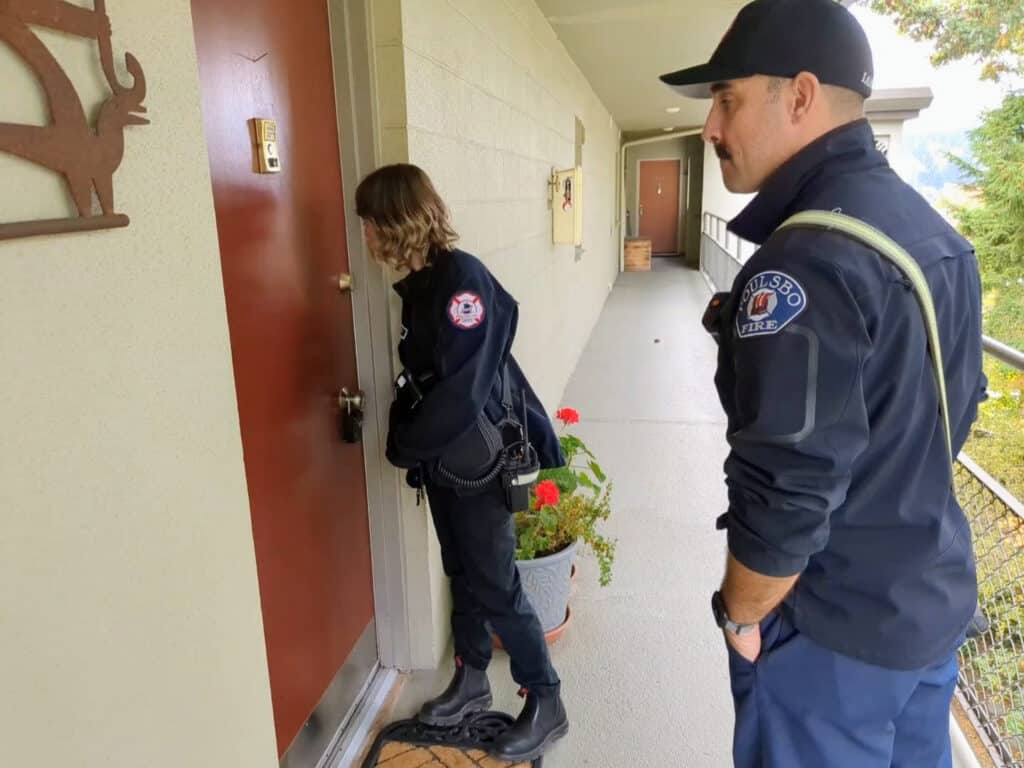Community Health & Wellness Police & Fire
‘Washington needs more’ programs like this one, auditor’s report finds
From the passenger seat of a department-issued Ford Explorer, Victoria Effray pulls a piece of paper out from the sun visor. Parked in the driveway of a large home on Bainbridge Island, the social worker peers at her list to confirm the identity of the 99-year-old man she and her partner are there to meet.
Community Sponsor
Community stories are made possible in part by Peninsula Light Co, a proud sponsor of Gig Harbor Now.
Firefighters responded to a 911 call at the same home a day earlier. The man fell and needed a ride to the hospital. Effray and partner Lt. James Pratt — members of Poulsbo Fire Department’s CARES team — are there to check on him.
CARES teams like Poulsbo’s connect with people who firefighters believe may benefit from additional support. These programs have become increasingly common for state fire agencies and been found to significantly reduce reliance on the emergency medical system and hospitals.
CARES teams
That leads to better outcomes for individuals and widespread cost savings, according to a report released by the state auditor’s office last month.
The report, Reducing nonemergency use of Emergency Systems, surveyed eight of the estimated 52 CARES teams in Washington. It found that while they vary somewhat by region, all were a cost-effective solution to frequent, non-emergency use of emergency medical systems.
That is a common problem in areas with limited primary care options, like Kitsap. Auditors wrote that “Washington needs more of these programs,” and state officials should work to stabilize their uncertain financial future.

Victoria Effray and Lt. James Pratt, members of the Poulsbo Fire CARES Team, knock on a door in Bainbridge Island on Oct. 23, 2025. Photo by Conor Wilson
The report confirms what officials in Kitsap largely already knew. Six months after intervention by a CARES team, call volumes to 911 dropped by 68%. The decline, they argue, is an indication the program has effectively addressed low-acuity needs without emergent intervention, saving time, resources and lives.
“You can never, never quantify the medical emergency you prevent,” said Poulsbo Fire Chief Jim Gillard. “But we know when you’re talking about reducing hundreds of calls, and you know some people are seriously sick or ill, you are potentially saving lives.”
CARES expands in Kitsap
Calling 911 and going to the emergency room is often the most expensive way to get care. It diverts firefighters from other emergencies, strains hospital emergency rooms and drives up costs for taxpayers, hospitals and insurance providers.
Yet in Kitsap County and other communities suffering from a shortage of preventive care options, the emergency system often becomes a safety net for people who cannot otherwise access care. That generally leads to worse health outcomes. The emergency system is designed to stabilize, not address long-term needs.
The CARES Program aims to address that situation. By following up with people who called 911 and seeing what resources they might need, the team reduces preventable and repeated 911 calls and hospital visits.
“We’re meeting the needs of the community as it’s defined by 911 activations,” said Julie Rogers, the Kitsap Fire CARES program coordinator who oversees three teams in the county. “That’s needs in our community that are not being met.”
The CARES — or Community Assistance, Referral and Education Service — teams find out what support an individual has and what they may need. Do they have families or friends nearby? A primary care doctor? Would they benefit or want any services already available in the community? Do they have any barriers that prevent them from getting help? From there they connect people with everything from fall prevention resources like walkers to behavioral health treatments or food assistance.
Behavioral health help
Fire agencies in Spokane and Bellevue pioneered the first CARES teams about a decade ago, after a new state law expanded their ability to hire behavioral health workers. Poulsbo launched the first CARES team in Kitsap County in 2021, pairing a social worker and a firefighter.
Firefighters and law enforcement in Poulsbo, Bainbridge and unincorporated North Kitsap pass referrals to Poulsbo’s CARES team. Effray triages them, connects with each resident and finds out what they might need. If they decline service or seem to have solid support networks, she closes their case. If not, she may make follow calls to agencies on their behalf.
“Firefighters or law enforcement go into someone’s home and, if they see a need, I can then bridge that gap,” she said.
Fire districts in Central and South Kitsap established CARES teams in 2023 and 2024, respectively. The three teams collectively serve five fire districts, covering all of Kitsap County outside Bremerton city limits. Next year, all three will employ two social workers (with Poulsbo removing firefighters from the team).
Gig Harbor
The teams contract with a substance use disorder professional at the Kitsap Recovery Center. Virginia Mason Franciscan Health, the parent company of St. Anthony Hospital in Gig Harbor and St. Michal Medical Center in Silverdale, also agreed to hire an advanced provider to work alongside CARES teams in the field.
Gig Harbor Fire and Medic One does not have a formal CARES program. But Chief Dennis Doan wrote in an email that the district implements many of the same principles through a partnership with the city of Gig Harbor “to explore community-based approaches that better serve our residents.”
“Gig Harbor has an aging population, and our EMS Division has focused heavily on building relationships with local long-term care facilities, historically a source of high and repeated 911 calls,” he said.
Ending the cycle
Gillard says launching CARES required a leap of faith. It marked a fundamental shift in the fire department’s role, expanding how it dealt with medical emergencies to include preventative work. Nevertheless, it felt imperative.
Previously, if someone fell, for example, first responders would stabilize them and potentially take them to the hospital. They would then be discharged back into the same situation. Nowhere in the process was the root cause of that fall addressed, meaning they may need to call 911 again in the future.
“They fall, we transport, the emergency department gives them great care and then sends them right back to the same environment and they’re just on a cycle,” Gillard said. “We just saw the futility of transporting the same people over and over again, not being able to make a true difference, knowing people would die, because they weren’t getting care to stop these medical emergencies.”
The logic behind CARES, Gillard says, is similar to the now decade-old practice of preventing fires. More than 50 years ago, firefighters in America were not incredibly effective. Thousands of people died annually in house fires.
That dismal performance became the subject of a landmark report known as “America Burning,” which described how the country had one of the worst fire problems among industrialized countries.
America Burning became a roadmap, arguing that education and prevention, like code enforcement, were fundamental to improving performance and protecting communities from fire. Gillard sees CARES in much the same light: a way to prevent future medical emergencies
“It just seemed so obvious that what we were doing with fire prevention we could do with EMS prevention,” he said. “Get people off that cycle and prevent people from having that emergency in the first place.”
Poulsbo provides a model for CARES
Gillard credits Kim Hendrickson, the city of Poulsbo’s Housing, Health and Human Service director, for introducing the Poulsbo Fire Department department to the CARES program. Hendrickson, who no longer works directly on CARES, said the program started out as an isolated project in Poulsbo, but has become a key link between first responders, the hospital and community service providers.
“What CARES has done is it’s encouraged different providers and different agencies to work more closely together in Kitsap County, which is so incredibly needed when we have a shortage of services,” she said. “The strength of CARES is its ability to pull parts of the system together.”
The long-term sustainability of CARES programs remains a challenge, especially with tightening budgets across the state. The state auditor’s report emphasizes that many of these programs cannot be sustained without consistent funding.
“That’s such an important point with the very real possibility that people in Washington are going to lose their health insurance in the coming year,” Hendrickson said. “It’s really wise for us to take that part of the auditor’s report seriously. These programs are in jeopardy without more consistent funding.”
The three CARES teams cost just over $2 million a year, Rogers said. Grants fund about $700,000 of that. As state and local agencies face ongoing budget challenges, those grants could become more competitive and less available.
“That is the key area of concern and risk that’s facing these programs,” she said. “And it’s one that’s in the front of my mind.”


